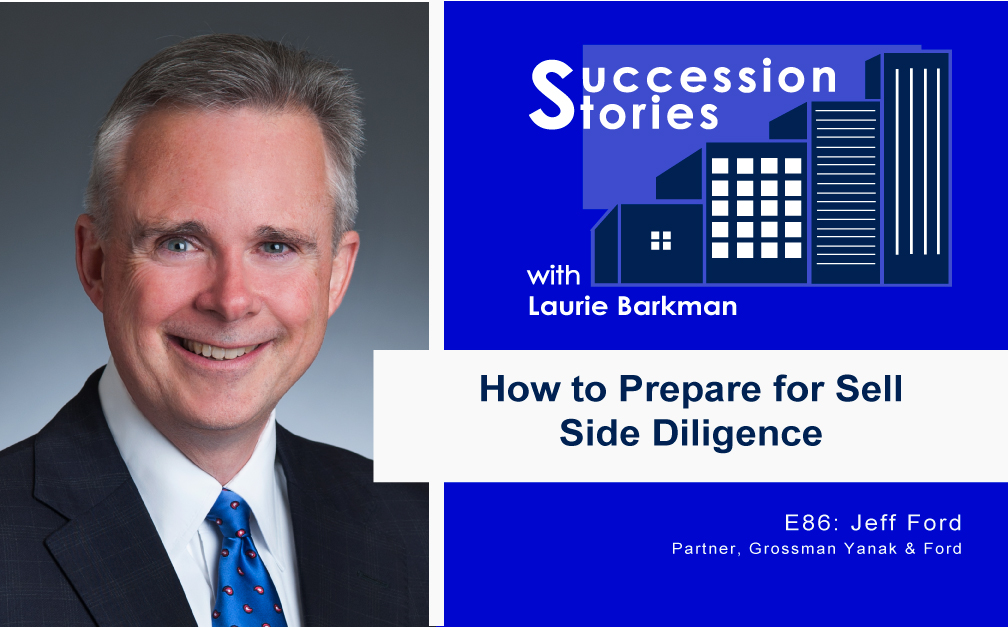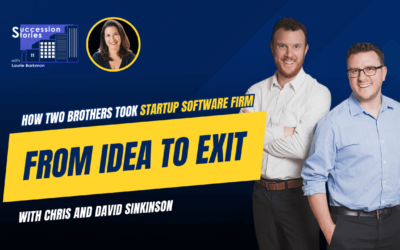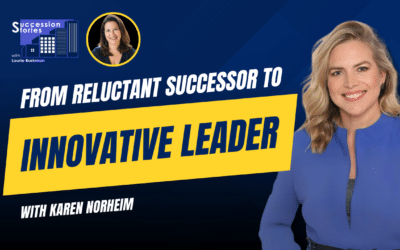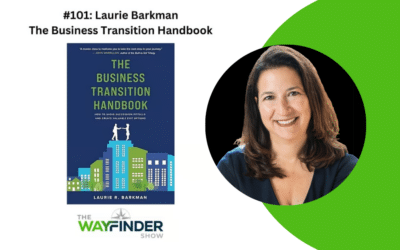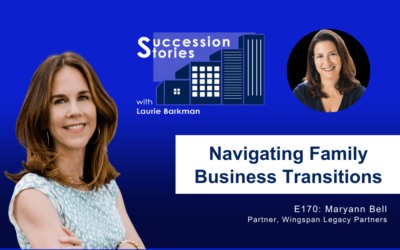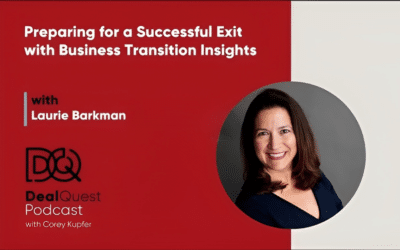This sell-side episode focuses on protecting the value of your investment. Laurie Barkman hosts Jeffrey Ford, a Founding Partner at Grossman Yanak + Ford, a regional certified public accounting and consulting firm. Listen in as they talk about the importance of having a transferable business, and how to address risks to protect your sell price. You’ll benefit from the discussion on what can derail the sale of your company and how to prepare for sell side diligence.
Listen in to learn more about:
- Sell-side insights for business owners thinking of selling at some point
- What the buyer’s team looks for to drive down your selling price between the Letter of Intent and the transaction
- Conversely, how the business owner can prepare and take the time with a thoughtful, introspective approach
- Assembling a capable deal team philosophically aligned with the business owner, that will pay off significantly in the process
Show Links:
Grossman Yanak + Ford website: www.gyf.com
Email Jeff Ford, Partner GYF at ford@gyf.com
About Succession Stories Podcast
Succession Stories is hosted by Laurie Barkman, the Business Transition Sherpa– guiding business owners through the process from “transition to transaction.”
Learn more at https://thebusinesstransitionsherpa.com
Book a 1:1 Advisory call at:
We appreciate your support…subscribe, share, and post a review to share what you like about the show!
Don’t leave your exit to chance.
Stony Hill Advisors works with owners like you to get ready and maximize value when you’re ready to sell.
Visit www.stonyhilladvisors.com/podcast for a complimentary business valuation.
Transcript
Laurie Barkman:
Jeff Ford, welcome to Succession Stories. I’m excited for our conversation today, you have so much experience as an entrepreneur, because you’re a co-founder, which, after 30 plus years, you might not look at yourself as an entrepreneur more as the expert practitioner in your field but nonetheless, you are a great resource for us, for our listeners, and I’m really excited to have you on today.
Jeff Ford:
Thank you, Laurie. I’m excited to be here as well and I think that entrepreneurial spirit never leaves a person if they have it, it stays with them forever so in spite of being the technical expert, certainly appreciate the perspective that the business owners have.
Laurie Barkman:
Yeah, absolutely, so let’s dive in at that point. The purpose of today is to talk about your expertise. Why don’t you tell us a little bit about you and your firm Grossman Yanak & Ford?
Jeff Ford:
Grossman Yanak & Ford is a full service CPA firm based in western Pennsylvania. We are still independent, we are independent with localized decision making. We’re part of an international group of firms so that we can do things internationally or at larger scale than we would ordinarily be able to do if needed but here, we focus on about 70% of our work within a two hour radius of Pittsburgh and the remaining 30% is spread throughout the United States. We focus on the standard things you would expect from a CPA firm; audits, reviews, tax compliance, and so on. We also have a vibrant valuation group and a vibrant ERP solutions group. Across all of those groups, we bring a particular expertise with regard to business transactions, both buy side and sell side and that has been true since our inception in 1990. We do everything from buy side advisory due diligence, working capital assessments and reports and so forth, to sell side advice, which we’ll be talking about today, and also dispute resolution and expert testimony on purchase price situations.
Laurie Barkman:
That’s excellent, the broad range of services across different industries and size of companies. A lot of the folks in our audience are probably in the lower middle market, we may have some listeners that are part of larger corporations but if we put ourselves in the chair of the business owner, I think this is going to be a really good conversation, because we want to, the ethos of this show does help people understand some of the concepts they may not be familiar with. A lot of folks who are looking to maybe sell their company one day, this is the only time they’re going to go through this transaction so they maybe don’t know what it’s all about yet so I think to start there and say, “Great, let’s focus on the business owner,” and if they’re going to sell their company, a key phase that they’re going to be be involved with, is what we refer to as due diligence, and how do we prepare for that? Why don’t you give us a little bit of a scenario, what would be a typical scenario, at this stage of a process when a business owner is contemplating a sale?
Jeff Ford:
Well, I’ll give a variety of scenarios for the lower middle market that you mentioned, focusing on a few million, maybe 50 to 75 million in transaction value, and maybe a handful to several 100 employees. The theories are the same. When you get larger, it’s just your deal, team size and the amount of money you spend changes. It’s a little bit more self-focused, a little more do it yourself, with a smaller group of kind of a SWAT team, if you will, in the lower middle market. Oftentimes a business owner ponders selling for quite a long time before they prepare to sell, they’re tempted and so forth so in that scenario, they usually have some amount of time, they’re usually thinking about it, they usually assemble this the formation of a deal team or the early semblance of a deal team and that would be a legal adviser, maybe an investment banker, maybe some advice from their accountant or other financial advisors. Then over time, they come up with a strategy to sell or exit. That’s the orderly process. In another percentage of cases, it comes up a little more suddenly. It comes up suddenly because in the event I thought my child was going to be in the business, they change their mind, have an unexpected health problem, or the happiest event is a stupid offer out of the blue, they got an offer well beyond what they ever thought, they didn’t want to sell the business but it’s 15 times EBITDA, they no longer want to keep the business. In that case, and in this rapid turnaround scenario, I think it’s still important that the business owner think about preparation, just dive in and start talking to your suitors. You assemble that deal team, you confer with attorneys, with financial advisors, accountants, you confer with investment bankers, maybe you do run a process so I think in either scenario, I’m saying preparation is helpful.
Laurie Barkman:
Preparation is definitely helpful. A lot of times I get asked the question, “Well, how much time do I need?” and then of course, you flip it around to say, “Well, how much time do you have?” and the longer time you have, the better off you’ll be because you’ll have more time to make changes and create more options for yourself in the future. Is that what you see as well, Jeff?
Jeff Ford:
It is, and if you give me the liberty to be honest, direct and respond respectfully, I will be direct and most business owners are direct, so how long it takes to get ready for a transaction is analogous to asking someone how long does it take to get into shape physically but the answer is largely, how good a shape are you in before we start, and how much time and commitment will you put into the process? The less time and effort you’ll put into the process, or the worse shape you’re in the beginning, the longer it takes to be ready. The one thing I will assure you is if you’re not ready, that will be brought to the light of day in the buy side due diligence by any reasonably capable suitor.
Laurie Barkman:
That is a really interesting visual, I now cannot get out of my head, Arnold Schwarzenegger in the 1970s ready for the transaction. He is ready, as opposed to someone else who’s going on, you know, My 1000 Pound Life?
Jeff Ford:
Well, and I think a lot of business owners do live that way. They do live ready to sell, maybe it’s certainly not the majority, but a lot do it. There’s books Built to Sell and very similar ones and some business owners are just wired that way. They’re just always always ready. They’re just particular, they might lean towards perfectionism. They have every i dotted, every t crossed, they have every legal document there. They’ve analyzed the SWOT analysis of their business from every angle, they’re pretty close to ready. They’re pretty close to ready. Now, I think the majority of business owners get consumed by working in the business, not on the business as the old saying goes and I think that they know that they should be doing a lot of things but those things get wherever is further back behind the back burner, they get pushed so far back, they’re just not tended to until it becomes something of an urgency and I think that’s who we’re talking to more today.
Laurie Barkman:
Right? Let’s take the scenario of a company that is interested in selling, and maybe they have some suitors, then there’s some letters of intent on the table and one of those is chosen to move forward in a process where we want to get to a purchase agreement. Where does due diligence fall? Is it once the letter of intent is signed? Is it beyond that and once we know for sure that there’s a purchase agreement, or is it somewhere in between?
Jeff Ford:
I want to add a different perspective to that you described. I think ideally the timing for buy side due diligence, the buyer wants to be ready and the buyer typically performs their buy side quality of earnings or financial due diligence during the exclusivity period that typically kicks off with a letter of intent being signed and agreed upon in some way. Conversely, when one does that on the buy side, it’s time pressure, you have whatever — 45, 60, 90 days of exclusivity, and it’s really intense and highly focused. Conversely, on the sell side, I think it should be approached very differently than that. I think on the sell side, you want to be prepared well in advance of a letter of intent, I think you want to walk through it, you want to get things out in the open when you have more time. Ideally, I realized that the exit planning attorneys and others say start three years before you want to sell but from a financial diligence side sell side QofE, one year is fine, six months we could work with but if you’re doing your sell side diligence, when you have an LOI from a suitor, you really are scrambling, your back is against the wall, you have given several advantages to the other team. That doesn’t mean you can’t win. But you’ve given several advantages to the other team and I think our role and your deal team’s role is to help you to amass as many advantages on your side of the table as you can possibly comfortably do.
Laurie Barkman:
You mentioned the QofE. What does that stand for — quality of earnings? What does that mean?
Jeff Ford:
Well, thanks, Laurie, I probably should have said that since we live in that world. Quality of earnings or QofE is really a financial assessment of a business in their situation. It usually involves several areas and involves an overview of the industry. It’s not to be confused with the information memorandum or the selling memorandum that the investment bankers do, but there’s often some overlap but the QofE goes a little bit deeper into the financial side to be sure. It talks about the industry, talks about strengths and weaknesses in the industry, talks about the purported strengths and weaknesses of the company at hand in this case, the seller’s company. It typically focuses on things that would be of interest to a buyer. Think about what a buyer would be excited about or worried about. That’s how the seller should be thinking. Most sellers underestimate the number of things a buyer would be worried about. A seller lives in there, they know the risk, they don’t think about it, they’ve been comfortable with it for a decade or two but if they were in the other chairs, they would be worried about a lot of things. They want to know the story but they also know that sellers tend to embellish this story. They want to know the story but they also know that sellers tend to embellish this story so now the sell side the QofE is really saying, “How do we lay something out there to facilitate the buyer’s process? How do we calm the buyer’s fears? How do we tell them a concise, accurate story about the financial situation of this company? If there are audited or reviewed statements, which are very helpful, we’ll refer to them, they will not be incorporated in their entirety, but they will be referred to, we will have a section on working capital, what is the normal working capital that we might need to run this business? Sometimes it’s cyclical, sometimes it’s kind of consistent. Sometimes there are significant concentrations of customers, almost everybody thinks of the customer concentration. If 80% of your businesses have one customer well you better have a good story as to how you keep that customer. Similarly, the concentrations aren’t always the customer. If you require something for your secret sauce, it’s available only in one place. Very important to tell that story. We did a sell side QofE work probably four or five years ago – now the years blend together – for a company, a neat company, great product, great margin, their margin was enhanced because of this minuscule, inexpensive item that really allowed them to achieve tolerances that excelled beyond their competition, and really drove their premium margins, which in turn, of course, drove their premium price. That particular little widget was only available from one source. That would worry a buyer a great deal. We addressed that in the sell side QofE, we addressed the continuity arrangement. The legal team also helped with bringing calm to that situation and really averted a challenging conversation later.
I want to be careful by going on and on but you introduced a very, very important question. Other concentrations might be with who owns the sales relationships? Oftentimes, it’s the business owner. Are they transferable? Will those customers talk to the new owners? Will they be loyal? Or would they merely go to their second favorite provider? My favorite is one we didn’t see coming, but we stumbled upon it. We were deep in the due diligence process in the sale security and we learned that of a group of salespeople, most of the salespeople had virtually no book of business. A majority and a super majority of the sales book of business was with one salesperson so we said, “Well, can we talk to that salesperson?” “Well, he only comes in a few days a week, because he’s over 75 years old.” Wow, that was worrying me a lot. If I were a buyer, right, put yourself in the buyer’s shoes. Now the seller in this case would think about it because they were used to dealing with this gentleman. Over the course of several decades, the salesperson was highly competent, highly dedicated, highly successful, and it wasn’t even on their minds , so now putting ourselves in the side of the buyer we basically, we didn’t come up with it, we were part of the collaborative team that came up with the transition plan, from the more experienced salesperson to what would happen, how do we transfer these relationships. In in this case, he was willing to commit several years to a buyer to also facilitate that transition, but I will say completely directly and bluntly, that if that was not done ahead of time, if we were serving the buyer side, we would have made that a big, big deal and we would have made sure that that informed significantly the negotiations of purchase price and other terms of that agreement so a QofE really helps to get a number of items, concerns on the table and also opportunities. This is why this is so excellent. This is why with a little bit more resources, we could do so many more things and this is why we didn’t have the resources or aren’t inclined to invest them.
Laurie Barkman:
Yeah, and I love that process. For me in the way I work with clients, it’s a little bit similar. It’s not a quality of earnings, but it’s the same intent, which is, let’s start early enough so that we’re looking at the risks in your company, so that we have the time to address and that’s what you’re saying is really key. Especially if it’s on the buy side, the clock is ticking and it’s going to be reflected in the purchase price because they’re going to discount based on whatever risks they find and what gets flagged, it’s going to represent a discount so if you have time on your side, to not only identify what what potential pitfalls you might be facing, but then do something about it to make changes whether it’s on the sales side, whether it’s on the infrastructure, the customer concentration risks, etc. Right?
Jeff Ford:
Absolutely. I will say that if you have the perfect business, there’s no need to do any of this but I haven’t met the perfect business yet. Many business owners are apt appropriately, they’re proud of their business. They work hard. They’re apt much like a parent to overstate the brilliance of their business, just like we overstate the athletic abilities of our children or the brilliance of our children. It’s very, very similar but almost every business has issues, has challenges, and we want to get those circulated, we want to get them on the table while we have time to do something. That’s really one of the key reasons you want to do a sell side QofE. You have to do it much earlier in the process than a buy side, you want at least a year, because when these are identified, some of them will be false. Some of them will be the business owner and their team telling us financial people that, “You’re just worriers,” and they’ll show us why it’s not a worry, we put that just like you’ll put it in the information memory, and then the selling memory, and then we’ll put in the QofE. This is why this may look like a worry. But here’s why it’s not a worry. That’s very helpful. Now, when we move down that path, there are some things that are legitimate worries, those concentrations, expiration of patents, aging of equipment, a workforce that’s all over a certain age with no ability to backfill it, any number of those things and this gives us the opportunity to kind of grab the high ground, if you will – I do like sports military analogy, so I hope you’ll indulge that – it’s given us the opportunity to grab the high ground and tell the story. This is the plan and this is why the plan is not only plausible, but actually feasible and here would be the investment to execute that plan and oh, by the way, if you don’t buy it, that’s what we’re going to do anyway. We’ve essentially executed if not an absolute fix, and fix it before we sell it, we’ve outlined the roadmap to alleviate the financial pressure, financial detriment that would come from it and we’ve taken away the emotion, the same issue that is highly emotional at the 11th hour, even if it’s not emotional. I’ve worked with enough buyers over the years to know that even if it’s small, and they kind of shrug their shoulders and I bring it up, they in their legal team then say, “You know, this sounds like a big deal, we’re going to make it sound like a big deal when we get back to the meeting,” and of course, my role is just to stay quiet in that regard and let them negotiate for their purpose but this really shines a spotlight on the problems that we can’t fix. If your business is normal, it’s going to have a few weaknesses that are just not going to be fixed. Having those be surprises discovered by buy side diligence will cost you a lot of money. No doubt about it. One of the few absolutes if we can get those on the table, and have them desensitize ahead of time it will go a long way. We acknowledge it yes, we will always have this weakness. It’s inherent in what we do, here’s how we’ve overcome it. Here’s how we may continue to, and sometimes the buyer’s advisor or the seller’s advisors, such as yourself are very good at getting an auction rolling and telling people that, “We need you to acknowledge this ahead of time before you go through door number one, we need you to accept that 80% of the businesses with one customer and we’re confident that they stay,” and you can really take a lot of those difficulties off the table and oftentimes increase your your sales price by one or more turns of EBITDA, which can be a lot of money.
Laurie Barkman:
A lot of money. It’s counterintuitive to think that it could benefit you by putting some of the words out front, as opposed to hoping that no one discovers them and it’s a good encouragement to desensitize, address them upfront, be proactive about it, again, probably very against emotional sensibilities that we think, “Oh, wait a minute, you know, I don’t want to put the negatives out there,” but I liked how you positioned it.
Jeff Ford:
Well, I think it’s very important for business owners and I think they understand when they put themselves in the shoes of a buyer buying your business, they actually know better than anybody where the real concerns are, and really what to do about them. They’ve been living that story successfully for some period of time.
Laurie Barkman:
Absolutely, so when you look at cash flow, sometimes in owner led businesses, family businesses or smaller companies, we need to make normalization adjustments to account for and again, it can happen in larger companies too, of course, where there’s one time expenses or one time revenues that would not get repeated and so we don’t want to necessarily count those in, in the net income and cash flow estimates. How does that come into play? What are the types of things that are watch outs?
Jeff Ford:
Well, we’ll talk about both categories of normalization adjustments, those that improve the EBITDA on those that take away from the EBITDA and what most buyers are looking at would be negative adjustments to EBITDA, one time income that won’t recur, as you mentioned, and then want to normalize that they’re usually looking at either a trailing 12 months, but or maybe a three years or a business cycle if you’re in a longer business cycle cyclical business, but they want to know what does this business look like going forward? Because none of us are very good at predicting the future typically, we use the past as the best proxy for the future and one of those scenarios is, “What is the most normal?” That’s why they call it normalized. If the business has been very successful, and the business owner has been taking, I don’t know several million dollars a year on as compensation, and maybe paying their child another million a year, to stay on the ski slope somewhere, anything nice that people come up with to do, that would be a normalization adjustment to improve the earnings, that would be saying, “Gee, let’s add back those monies,” because if I own this business as an absentee owner or a new owner, I wouldn’t pay myself that much. I wouldn’t pay my child that much. What would I have to pay to replace the functions that I perform, that’s an adjustment to it but you do the same thing with a one time thing.
Very popular ones of late would, of course, be the pandemic related adjustments, whether it’s the PPP or the ERC, or shutdowns or partial shutdowns or anything along those lines. But even pre-pandemic, and certainly post-pandemic, people adjust their business, they might cease a product line, they might move facilities, might combine facilities so if you shut down a facility and you combine facilities, there’s typically an impact of that. What is it? How do you measure it, put it out there? Take the high ground again, measure it. There’s usually a range of fairness and it’s to the business owner’s, the seller’s advantage to grab the front of the conversation, and have most parts of that range of fairness skew a little bit their way, in making the argument as to why that normalization adjustment should lean in slightly to their advantage. Now recognize it’ll be a discussion point, recognize that it can’t be outside that range of fairness, if you want to defend it, but they do go both ways. We’ve talked compensation, we’ve talked one time things, it can be any number of other things. Sometimes it’s a commodity thing, if sometimes you’re merely normalizing for highly volatile supply situations, anything that’s going to change, the run rate of the business should be looked at for normalization adjustments.
Laurie Barkman:
Okay, that makes sense. Essentially, we’ve been talking a lot about risks and a company that isn’t transferable is inherently risky, too dependent on the owner. Some of the reasons we mentioned earlier; they are the ones that are in charge of the sales process, or there’s really not well established processes in general for products or services that can be transferred and so that constitutes risk. What do you see are the most common risks that are derailing a transaction?
Jeff Ford:
First, I want to address the one that you moved to, and then I’ll move to a couple other common risks. The risk of being too owner centric is huge. If a business does $40, 50, 60 million, it’s not likely but if it’s 1 million to 10, 15, 20, 25, it could be very likely. I can’t remember the name of the author who wrote a book called I think it’s Mindset, I can’t remember her name, but she did a nice job and she had a premise in there that some businesses and you can also look at The E Myth, The E Myth Revisited, about the Craftsman versus a business. Some businesses, even large ones can be a genius with a bunch of helpers. That’s a risk. That’s the risk you just mentioned. Others are a business where the owner is part of the team, they’ve instilled capabilities and authority and motivation in a team and that has much less risk. Because if you’re dependent upon the genius, you can always get the helpers, right, and the genius goes away the value of the business, the grants, that is where many business owners start and why many actually hold off on the sale, once they start going through a sales process, they realize, “We’re not saleable because it’s all about me, I’m the only value of this business. Oh, by the way, I’ve been taking all the value monetarily out of the business every year to support a lifestyle or my investments or whatever, and there’s really nothing there,” and it’ll take longer to sell.
The more that business owner has either build a true business, or they have a team around them that can be sustained or transferred or by the way, oftentimes, when we go through this process, not oftentimes, sometimes in the analogy to what’s on HDTV, sometimes they love it, instead of listing it, sometimes they look at it and say, “You know, this really is a business, I really can’t do this absentee. I really can’t hire a professional manager, I really can’t let my underperforming child or niece or nephew run it and I really will just now keep it,” that sometimes comes from this process, because the business owner now sees it from the buyer’s perspective, but it’s a giant risk in how dependent the business is on the business owner and that will oftentimes derail a sale of any financial consequence. Other risks tend to be contingent liabilities, what’s lurking out there? Do you have defined benefit pension plans? Well, that scares nearly any buyer, as it should. Do you have environmental liabilities, anything where the rules are changing, and it might become very expensive very quickly or it will not go away or cannot be accurately predicted? You have other contingencies pending or threatened litigation. Everybody knows that. Might I be sued by somebody? But do you have a patent infringement issue? Do you have a patent that you can’t hold on to or defend? Are you too small to actually defend your territory, your intellectual property? All of these things are big risks in a buyer’s eyes. Warranty risk, you have a lot of rework lurking out there. Might you have a product liability risk that you don’t know about yet, an incurred but not reported type of thing that will be stuck on it even if the buyers indemnify, the buyer knows it will impair their business going forward but they might have to directly or indirectly pay for it. Most of the other risks come from contingent liabilities and that includes the fact that we’ve already talked about some of the other risks, like a work response and tration and so on.
Laurie Barkman:
Yeah, absolutely, so if you were gonna give a few pointers to a business owner who’s listening and say, “These are the things,” three things that they should really consider and take away from this conversation today, what would those be?
Jeff Ford:
I would say, prepare in advance. Prepare with the attitude of being the buyer of your business, some business owners are actually pessimistic while I was arguing the other giving an example of the other. Look at it objectively, dispassionately and objectively. Where are the risks in this business? Where are the opportunities? What would I need to clean up if I’m going to keep this thing? What would worry me if I were buying it, it’s just to dress them and give yourself time. If you think you could clean this all up in six months, it’s like most of the things in life, it’s going to take longer. If you think the hole is three feet deep, by the time you look more thoroughly it is probably deeper so just give yourself time and also don’t skimp on the team, a good team will truly pay for itself so don’t skimp on the team. Make sure they’re capable. Make sure they’re willing to give you proper share of mind so that you’re not getting the short end of their attention span and make sure that they’re philosophically aligned with you. You want folks on your team who will do it your way and respect your wishes. Not just have their capabilities in their way so I would say be prepared. Give yourself time. Don’t skimp on the team. Make sure that team is capable and aligned with your philosophical perspective.
Laurie Barkman:
Awesome advice. What’s the one thing we might be surprised to know about you?
Jeff Ford:
I have no idea. I’m such a simple straightforward person, I have no surprises in me.
Laurie Barkman:
Come on, you can make up something like GYF is really a band name.
Jeff Ford:
No, my favorite job because people think this will be my favorite job – and it’s great and I love the people I work with here as my teammates, and it’s really inspiring to work with the business owners and business people we work with – but my favorite job was as a Whitewater River guide a long time ago. No longer physically equipped to do that job, but my favorite job is not being a partner in GYF, it was being a river guide a long time ago in the summer sun.
Laurie Barkman:
Oh, amazing. Which river was that?
Jeff Ford:
Guadalupe in Texas.
Laurie Barkman:
How about that? That is good trivia. I’m glad I asked you that question. I love to ask everyone who comes on the show for inspiration. You’ve given us a lot of food for thought and words of wisdom, which I definitely appreciate. Do you have any favorite quotes that you’d like to share?
Jeff Ford:
I love quotes, I use them, I overuse them and I’m going to use a long one because I think it’s only a third of a page, because I think it resonates with business owners. It’s what I try and tell people who are advisors in coaching them to think like a business owner and it’s from Teddy Roosevelt from somewhere around 1910. It’s called The Man in the Arena, and it reads as follows. Teddy said, “It’s not the critic who counts, not the man who points out how the strong man stumbles, or where the doer of deeds could have done better. The credit belongs to the man who’s actually in the arena, whose face is marred by dust and sweat and blood, who strives valiantly, who errs who comes up short again and again. Because there is no effort without error and shortcoming. But who does actually strive to do the deeds, who knows great enthusiasms, the great devotions, who spends himself in a worthy cause. who at the best knows, in the end, the triumph of high achievement, and who at the worst, if he fails, at least he fails while daring greatly, so that his place shall never be with those cold and timid souls who know neither victory nor defeat.” That’s the difference between a business owner and somebody that always tells that business owner what they should or could or would have done.
Laurie Barkman:
We want to be empathetic and we want to be valuable advisors to business owners, but appreciating they’re the ones in the trenches.
Jeff Ford:
Absolutely.
Laurie Barkman:
That’s a great quote. Thank you so much for sharing that. If people want to get in touch with you, Jeff, what’s a great way to follow up?
Jeff Ford:
Best way is gyf.com. As you mentioned, we’ve been around a while so we have a three character URL gyf.com and you can see our BIOS at gyf.com as well.
Laurie Barkman:
Awesome. Thank you so much for coming on Succession Stories today. I really appreciate you.
Jeff Ford:
A lot of fun, Laurie, I appreciate it as well. Thanks.

